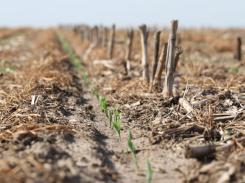Corn on Corn Study Explains Yield Losses
DECATUR, Ill. (DTN) — Continuous corn can take a toll on crop yield. That’s true even in intensively managed corn-on-corn fields, according to a six-year study conducted by the University of Illinois. 
It takes intense management to make corn on corn work without a yield penalty. A six-year study in Illinois points to a need for rotation. (DTN photo by Pamela Smith)
The report found continuous corn yielded 25 bushels per acre less than corn planted following soybean. Nitrogen (N) was the most important factor in explaining the loss. The continuous corn yield penalty decreased as soil nitrogen supply increased.
The number of years the field was planted to corn was the second-most important component of the yield penalty, according to the study.
Weather proved to be the third yield driver. The continuous corn yield penalty increased as weather conditions limited N. While also a factor in corn/soybean rotations, the study pointed to a more profound influence in continuous corn.
In a news release, DuPont Pioneer concluded that the two important management practices for achieving high continuous corn yields include planting continuous corn on highly productive soils and managing corn residues.
University of Illinois soil scientist Laura Gentry and crop physiologist Fred Below authored the study on corn-after-corn challenges. “In that study, we found stover accumulation in continuous corn to be one of the greatest drivers in reducing yields,” Gentry told DTN.
For more on the University of Illinois study and managing corn on corn, go to DTN’s story: Click Here
For more information on Pioneer’s continuous corn studies, Click Here
Story by Pam Smith:

